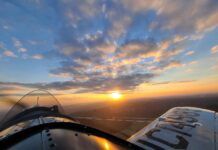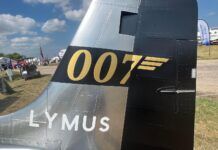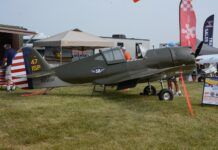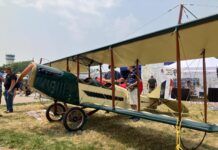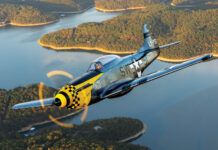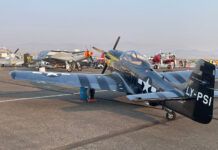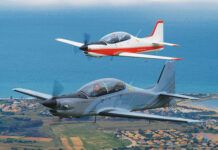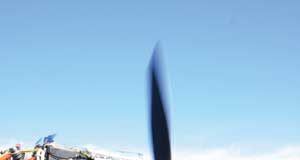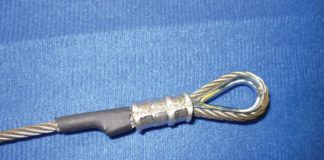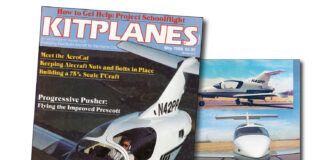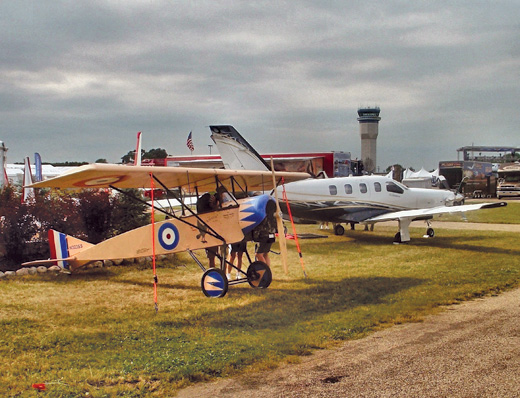
Sunday afternoon, after the crowds had gone. The Morane sits beside its great-great-great-grandson, a Daher-Socata TBM 850.
Oshkosh AirVenture 2011 featured a first for The Dawn Patrol. Normally we are either positioned down at the south end of the field, along with the ultralights and Light Sport Aircraft, or up at the north end with the Replica Warbird Association.
Not this year! Though we normally hoot with the owls, this time we were soaring with the eagles. My wife, Sharon’s, Airdrome Aeroplanes 1915 Morane Parasol fighter replica was definitely sniffing the rarefied air at the Aeroshell Plaza in the center of the show.
Soaring with Eagles
The story of how this all came about is convoluted. About a month before AirVenture we got a call from Robert “Bullwhip” Baslee, owner of Airdrome Aeroplanes, a company that offers an extensive stable of WW-I warbird replica kits ranging from scaled-down versions (like we fly) to full-scale versions.
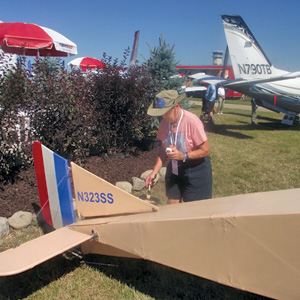
Sharon Starks goes over her plane one last time with a paintbrush and a small bottle of touch-up paint.
Baslee had been contacted by Daher-Socata, which was looking for a Morane Parasol to display at the company’s set-up at AirVenture to celebrate the 100-year anniversary of Morane-Saulnier, the predecessor of present-day Daher-Socata. (In 1966, Morane-Saulnier changed its name to Socata. After a brief stint as a subsidiary of EADS, in 2009 Socata was purchased by Daher, and became the present-day Daher-Socata.)
Of course Sharon and I jumped at the chance, but we were also nervous about parking her cute little airplane next to its great-great-great-grandson, the TBM 850, which sells for around $3 million. Talk about pressure! Sharon went into an orgy of touch-up painting and cleaning before we put her little Morane on its trailer.
Arriving at Oshkosh, we were nervous about how we’d be received by the Daher-Socata people. As we slowly drove around trying to find the correct display area, a young woman came running up to our car. Misty Moore of the Daher-Socata company was our contact, and she’d been looking for us. She told us where to go and ran ahead, leading us to Daher’s display area. As we drove up we wondered what kind of reception we’d receive from these “high rollers.”
As it turned out, we couldn’t have been made to feel more welcome. In fact, a good crowd of these folks came out and pitched right in to help us put the airplane together. Then they all wanted to sit in the cockpit and get their photos taken. When they brought in an electrician to bury floodlights in the ground around Sharon’s airplane to light it up at night, we realized we really were soaring with the eagles. (I figure Sharon’s plane cost about the same as a set of wheel bearings for the Socata TBM 850.) For the rest of our stay at AirVenture, the staff at Daher-Socata were the perfect hosts, offering us drinks and access to their air-conditioned camper when we needed a break from the heat.
We had arrived and all was well. Now for the rest of the trip.
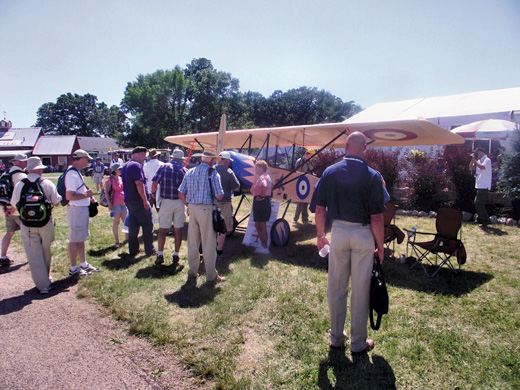
A WW-I plane is always a people magnet. The crowds were like this around the Morane all the time. Sharon never even got a chance to sit down.
The Presentation
I was pretty nervous. I’d given forums at Oshkosh before with no problems, but this time I felt a bit uncertain. I’d never faced an organized crowd of hecklers before. I tried to reason with myself that there was no way this bunch of hoodlums could be worse than an unruly class of eighth graders, and I’d faced plenty of those before in my teaching career. Sharon kept patting me on the arm in an attempt to reassure me.
“Don’t worry, Sweetie,” she said. “They won’t cause you any real problems.”
I was not reassured. And, boy, was she wrong.
I’d agreed to present a forum for the Replica Fighters Association on “Building and Flying WW-I Replica Aircraft.” I’d done it before in front of a friendly crowd, but this crowd was composed of guys who love to play jokes on me.
I looked out over the audience just before the lights went down and was not reassured. There they were: Tom Glaeser, Mark Pierce, Jeff Givens and Gary Knight sitting up fron, looking like a pack of hungry dogs eyeing a bone. All of them are members of The Kansas City Dawn Patrol.
Sitting in front of them was the big kahuna himself—Robert “Bullwhip” Baslee, who was at the show with his newest design, a full-scale, two-seat Sopwith Baby. Baslee had listened to all the requests for a two-seat WW-I aircraft, and he’d come through with one. The Baby is one heck of a plane.
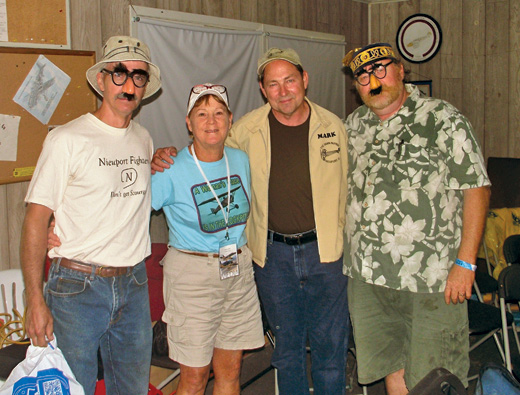
The head hecklers, from left to right: Rick Bennett, Sharon Starks, Mark Pierce and Butch Witlock after the forum.
Baslee and the late Graham Lee are the reason that many WW-I replicas are taking to the air in increasing numbers. They opened the door to warbird replica flying and ownership to everyday people—the pilots who want to build and fly a warbird but who face the reality of limited budgets. There are a lot of them out there.
Missing from the mix were the two biggest potential thorns under my personal saddle: Butch Witlock and Rick Bennett. Those two heathens were the ones who T.P.’d my plane twice at the National Museum of the United States Air Force at Wright Patterson Air Force Base in Dayton, Ohio, during the biannual Dawn Patrol Rendezvous. They also really did a number on it at last year’s AirVenture. They had used two rolls of toilet paper on the poor airplane.
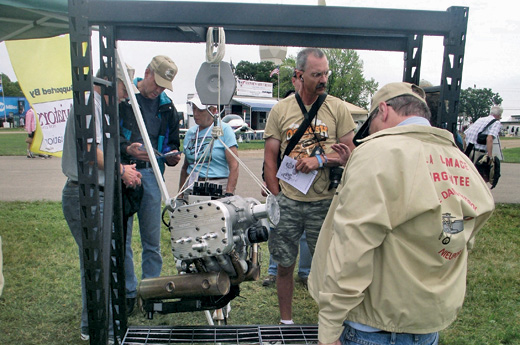
Jeff Givens and Sharon Starks look over the spec sheet on the 80-hp, 104-pound D-motor, while Tom Glaeser (his back to the camera) checks out the exhaust system.
I turned on the projector and started the presentation. About a minute into the program, the door to the side of the room burst open. Two ominous silhouettes stood in the doorway, starkly outlined by the bright lights behind them. Silence fell in the room, and all eyes were on the figures at the door. The tension mounted.
My worst fears were realized. The heathens were here. Witlock and Bennett had arrived, this time in costume. They both wore fake, black-plastic-frame glasses with big noses, bushy eyebrows and a mustache attached (shades of Groucho Marx).
After a moment of stunned silence from the crowd, Bennett spoke: “This isn’t working is it?”
After a good laugh we got back to business. I asked for a show of hands from anyone who had attended one of Baslee’s infamous “House of Pain” building sessions, and a pretty good sampling of hands went up.
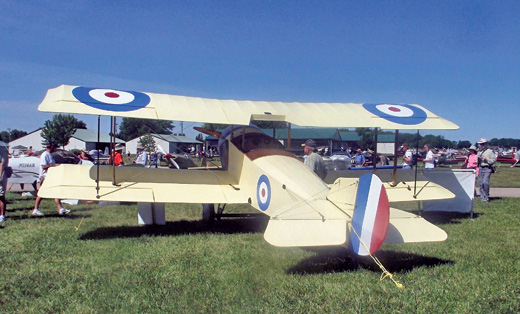
Robert Baslee’s long-anticipated new design: a full-scale, two-seat replica of a Sopwith Baby, powered by a Rotec radial engine.
The House of Pain (or HOP) building sessions are held at the Airdrome Aeroplanes plant, just a 30-minute drive east of Kansas City on I-70. These sessions are geared for builders of Airdrome kits who really want to hit the ground running. One weekend will likely have a builder leaving Monday morning with a fuselage on the gear, tail feathers finished and a good start on the wings. You’ll get more than a year’s worth of work done in three days, but be warned, it’s a long three days. As one admiring veteran of the HOP said, “Robert never straightens up. He just goes from one task to another with no hesitation and expects you to keep up. You definitely get your money’s worth during a weekend at the HOP.”
As for the forum, my fears were groundless. In fact, the crew of hecklers ended up fielding most of the questions about building and flying the WW-I replicas from the rest of the crowd.
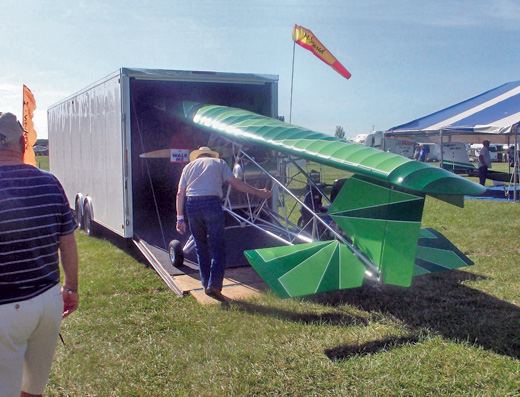
Larry and Gene Smith pull the new trigear swing-wing Back Yard Flyer out of its trailer.
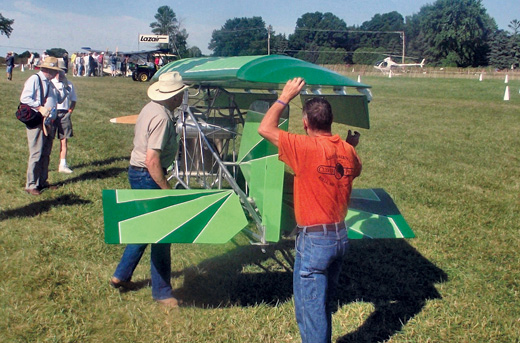
Larry Smith pulls the pin that holds the wing in place, preparing to rotate it 90° to its flight position.
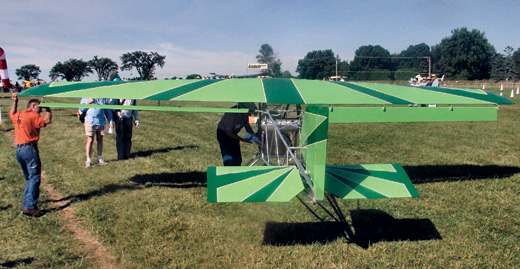
Two minutes later, the plane is ready to go.
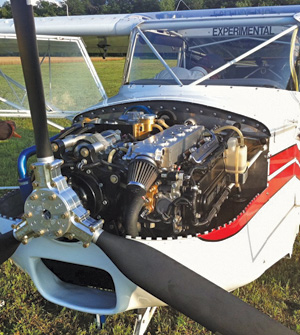
An Escapade Two with the 110-hp Viking Engine package installed. There were three different airplanes at Oshkosh with the Viking engine installed.
New and Exciting
Other areas of the AirVenture field featured exciting new engine designs, particularly lightweight four-strokes. The first one that grabbed my attention was a compact package called the D-Motor from Belgium. It’s an 80-hp, four-cylinder, liquid-cooled, fuel-injected four-stroke that weighs only 104 pounds. That includes engine, radiator, integrated alternator, integrated oil and water pump, ignition coils and a double-muffler (it’s also available with a single muffler that’s 1.5 pounds lighter). When you add the fluids (oil and coolant, 11 pounds), the oil tank (3.1 pounds), the engine computer module and harness (1.4 pounds), the water hoses and tubing (1.5 pounds), oil hoses (1.5 pounds) and oil cooler (2.6 pounds), it comes to 124 pounds with double mufflers (less with the single muffler). The final version that is going into production will have reinforcements on the castings that will probably add about 3 pounds. It’s a compact package at only 24 inches long, 21 inches wide and 15 inches high.
Another exciting design was the Viking Engine package offered by Viking Aircraft Engines in Edgewater, Florida. It’s a tidy 110-hp, liquid-cooled package. Included in the price is a 40A alternator, dual engine controllers, exhaust/muffler, air intake, K&N filter, starter, radiator, oil cooler, fuel pumps and engine mounting for your airplane. The engine is fully assembled. At $13,000 it seems to be a heck of a deal, and the static thrust of over 450 pounds is impressive.
WW-I replica builders who want a more authentic look need go no further than SCI Aviation’s air-cooled radial engines. These are the Sadler Radial engines under a new name. The company offers two models: The R1765U puts out 65 hp and weighs 125 pounds, and the R3125U delivers 125 hp and weighs 140 pounds.
Low and Slow
After a full day of aimless wandering around the acres and acres of displays, we were ready to go down to where we really belonged, the “low and slow” end of the field where the light planes and ultralights were on display. As far as we’re concerned, this is where the real action is. New designs are on display right beside the tried-and-true designs. Better yet, you can see the aircraft fly and get a feel for the performance they offer.
All of the props and engines on our airplanes (Sharon’s Kolb and Morane, and my Nieuport) came from Valley Engineering, so we gravitated there to talk engines with Gene and Larry Smith. They are the brains behind Valley Engineering and Culver props. Talking with those two guys is always entertaining and educational.
This year, Gene had finally crumbled and redesigned his little swing-wing ultralight as a tricycle gear. Man, is it neat! It takes just over 2 minutes to get from trailer to flight ready (3 or 4 minutes with my help), and it is still a Part 103 legal ultralight. The performance from its Valley Engineering Big Bad Twin 48-hp four-stroke engine is equally impressive.
There is much more that I could write about from the show, but alas, the editors would advise me to stop right here. Some people are just soooo picky. And still, the adventure continues.


